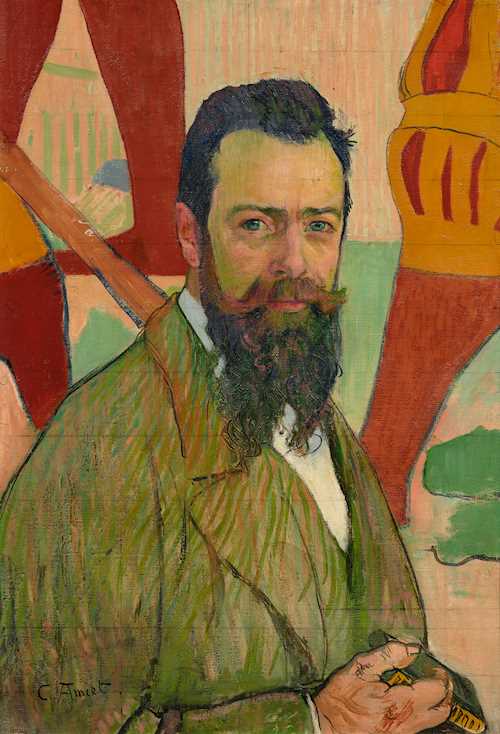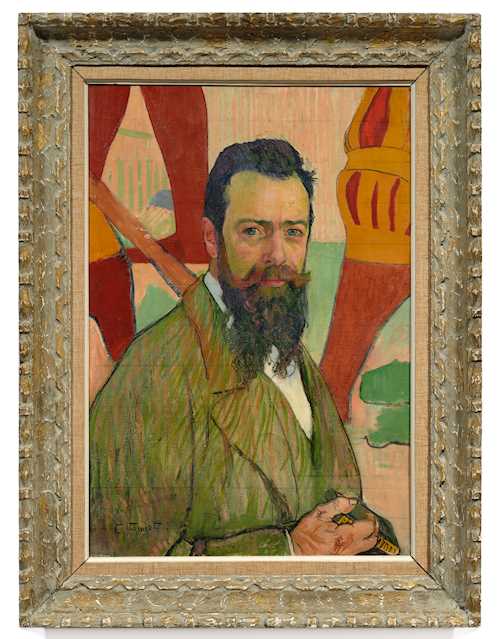
Lot 3029 - A209 Art Suisse - vendredi, 21. juin 2024, 14h00
CUNO AMIET
Provenance:
- Collection of Oscar Miller-Sieber, Biberist, 1902 (in exchange for the 2nd version, which Miller Amiet returned).
- Collection of Willy Russ-Young, Neuenburg, 1921 acquired from the above collection.
- Private collection, Switzerland, before 1970.
Exhibited:
- Vienna 1901/02, XII. Kunst-Ausstellung der Vereinigung Bildender Künstler Österreichs, Secession, 21.11.1901–8.1.1902, No. 36, as "Bildnis des Malers Hodler".
- Bern 1921, Hodler-Gedächtnis-Ausstellung, Kunstmuseum Bern, 20.8.–23.10.1921, No. 877, as "Bildnis Ferdinand Hodlers" (label verso).
- Bern 1928, Cuno Amiet und seine Schüler, Kunstmuseum Bern, 12.5.–22.7.1928, No. 70.
- Zofingen 1970, Von Agasse bis Welti, Galerie zur alten Kanzlei, March 1970, No. 50 (label verso).
- Cambridge 1970, Cuno Amiet – Giovanni Giacometti. Two Swiss Painters of the Hodler Circle, Kettle's Yard Gallery, University of Cambridge, 25.7.–15.8.1971, No. 1, as "Portrait of Ferdinand Hodler".
- Roggwil 2018, Cuno Amiet. Retrospektive zum 150. Geburtstag, Bromer Art Collection, 29.3.–1.7.2018.
Literature:
- Franz Servaes: Secession, in: Neue freie Presse, Vienna, 30.11.1901.
- Ludwig Hevesi: Aus der Sezession, in: Fremden-Blatt, 23.11.1901, p. 13 f., No. 322.
- Ludwig Hevesi: Acht Jahre Sezession. March 1897–June 1905. Kritik. Polemik. Chronik, Vienna 1906, p. 352 f.
- Oscar Miller: Von Stoff zu Form, Frauenfeld 1913, p. 52.
- Conrad von Mandach: Cuno Amiet, Bern 1925, plate 16.
- Cuno Amiet: Über Kunst und Künstler, Bern 1948, pp. 61 f.
- Willy Russ: Mes peintures et mes sculptures préférées, 1956, p. 14 (ill.).
- Eduard Plüss: Amiet, Cuno. Maler, Aquarellist, Zeichner, Graphiker, Plastiker, 1958/61, vol. I, p. 15.
- George Mauner: Cuno Amiet, Solothurn 1981, No. 3.
- George L. Mauner: Cuno Amiet, Zürich 1984, p. 36 (ill.).
- Cuno Amiet: Die Freude meines Lebens. Prosa und Poesie, Stäfa 1987, p. 51 (ill.).
- Geneviève Sandoz-Keller: Cuno Amiet. Les années symbolistes. 1897–1903, Neuchâtel 1988, p. 235.
- Urs Zaugg: Hodler-Zwang und Amiet-Lust, Langenthal 1992, p. 46.
- Franz Müller und Viola Radlach: Cuno Amiet. Die Gemälde 1883–1919, ed. Schweizerisches Institut für Kunstwissenschaft, Zürich 2014, vol. I, p. 166, or. 1898.04 (ill.).
- Exh.cat. Cuno Amiet. Retrospektive zum 150. Geburtstag, Roggwil 2018, p. 92, No. 1, as "Bildnis Ferdinand Hodler vor seinem Marignano-Bild".
Amiet’s financial situation began to change when he met the collector Oscar Miller in 1897. The director of the Biberist paper factory, who would become one of Amiet’s most important patrons, was not only a passionate collector of contemporary art, but also sought out personal contact with ‘his’ artists. Miller had become aware of Amiet a year earlier, when he saw his ‘Winter Landscape near Winistorf’ at the Swiss National Exhibition in Geneva.
Ferdinand Hodler had also come to Oscar Miller’s attention. Initially rather dismissive of Hodler’s symbolist paintings, Miller changed his mind when he saw a reproduction of the painting ‘The Night’ in the catalogue of the Seventh International Art Exhibition in Munich in 1897.
The artist Fritz Widmann arranged an introductory meeting between Oscar Miller and Ferdinand Hodler in September 1897, at Miller’s home in Biberist. In the same month, Miller also met Cuno Amiet in person, and visited him a week later in his studio, together with Ferdinand Hodler.
The encounters with the two artists prompted Miller shortly afterwards to commission a portrait of Ferdinand Hodler from Cuno Amiet.
At this time, Hodler was working on his cartoons for the ‘Retreat at Marignano’ for the armoury of the newly built National Museum in Zurich (see illustration). He had easily won the competition for this work. However, his monumental composition, limited to a few large figures, met with resistance from conservative circles, who had imagined a history painting of this importance would be rendered in a more traditional manner. The dispute, which lasted for months and was aired in the press, went down in Swiss art history annals as the ‘fresco controversy’.
Hodler was allowed to use the armoury in Bern as a studio for creating the large-format cartoons. Amiet painted his portrait here in the evenings after Hodler finished his daily work. In his memoirs, Amiet mentions that Hodler could not sit still for any length of time and repeatedly played his harmonica. Amiet later decided to transfer the portrait of Hodler, which he completed in a few sittings in a spontaneous brushstroke, into a second, more accurately executed version. Cuno Amiet kept the first version and gave Miller the second one, until a few years later when Miller asked him to exchange it for the first, more spontaneous portrait. Amiet later sold the second version to the collector Gertrud Dübi-Müller, who left it in her estate to the Kunsthaus Solothurn, where it is still today. The first version was sold by Miller to the art collector Willy Russ-Young in 1921 and subsequently passed into private Swiss ownership, until it was offered in this auction.
The painting in our June auction unites several moments that are of decisive importance for Swiss art and cultural history: the important promotion and support of two of the most important Swiss artists by the passionate collector Oscar Miller; Hodler's work on the ‘Retreat at Marignano’, which was decisive for Hodler’s mural painting and also made the artist a national celebrity through the ‘fresco controversy’; the friendly but also tense relationship between the still-young Cuno Amiet and his already famous role model Ferdinand Hodler, and finally the contemporary artistic trends which Amiet learned about in Paris, Pont-Aven and from his Swiss colleagues Giovanni Segantini and Ferdinand Hodler, and which he incorporated into this portrait.
CUNO UND FERDINAND
EIN FASZINIERENDES PORTRÄT VON FERDINAND HODLER
Zum ersten Mal konnten zwei Versionen eines historischen Porträts von Ferdinand Hodler von Cuno Amiet nebeneinander verglichen werden.
CHF 250 000 / 400 000 | (€ 257 730 / 412 370)
Vendu pour CHF 1 347 000 (frais inclus)
Aucune responsabilité n'est prise quant à l´exactitude de ces informations.


